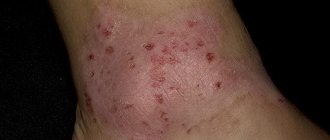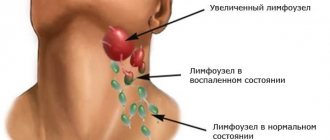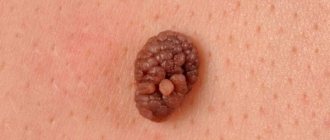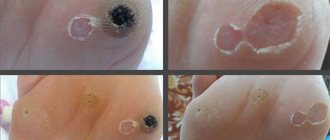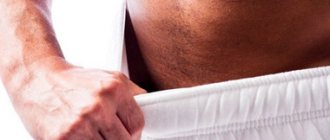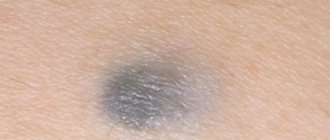(1 ratings, average: 5,00 out of 5)
Home » Fungal diseases
Determining the causes of yellow toenails is not always easy: the color, texture and strength of the nail plate can be affected by both external factors and internal processes.
Yellowing of nails in some cases indicates serious illness. Therefore, under no circumstances should the problem be left unattended.
Nail fungus, or onychomycosis
Yellow toenails are most often the result of a fungal infection. Onychomycosis develops with the same frequency in both men and women; the risk of its development is not affected by age. It is very contagious: performing a pedicure with non-sterile instruments, visiting a swimming pool or gym, using common household items with the patient ends in the development of the disease.
The fungus develops especially quickly in children - weak immunity and insufficient hygiene skills contribute to a rapid pathological process.
The most common pathogens of onychomycosis are Trichophyton rubrum, Trichophyton mentagrophytes and Epidermophyton floccosum, but in rare cases the nails are affected by molds and yeast-like fungi.
There are three forms of the disease:
- Atrophic onychomycosis - the nail acquires a dull whitish tint, becomes thinner, and becomes soft.
- Normotrophic onychomycosis - the strength and texture of the nail plate remain unchanged, but its surface is covered with yellowish stripes, dots and spots.
- Hypertrophic onychomycosis - nails turn yellow, thicken, become brittle and crumble easily, destruction of the nail plate is accompanied by an unpleasant odor.
! Congenital and acquired disorders of the immune system, diabetes mellitus, and the use of glucocorticosteroids make the body more vulnerable to fungal diseases.
Fungal infections are rarely localized exclusively to the nail area. Onychomycosis on the legs is in most cases accompanied by foot fungus.
Folk remedies
Alternative medicine recipes are not able to completely get rid of the main cause of yellowing of the nail plate, but they can whiten it. They can be used only after consultation with a dermatologist. It is also not recommended to combine herbal decoctions and pharmaceutical ointments at the same time. The most recognized recipes are the following:
- Add 30 ml of hydrogen peroxide to 100 ml of warm water. Pour the resulting solution into a metal container. Soak your feet in it for a couple of minutes, scrub your yellow nails with a toothbrush. Then apply moisturizer. Perform this manipulation once a week. As a rule, the positive effect is noticeable after a month of procedures.
- Take juice from three lemons. Make a nail bath using it, diluting it with water in equal proportions. Dip your feet into the resulting solution. The duration of the procedure should be a quarter of an hour. Then the nails are well rubbed with a toothbrush. At the end of the procedure, your feet should be washed well with clean water.
Consequences of pedicure
Varnishes and other pedicure products can give the nail a yellowish tint. At the same time, it does not lose its density, its surface remains smooth, only the color changes. This is the most common and at the same time the safest cause in women.
The following may cause a color change:
- Camphor oil. It is added to varnishes to improve their durability and ease of application.
- Formaldehyde resin, which gives the coating smoothness and shine.
- Nitrocellulose is the basis for varnishes.
- Toluene is a substance that improves the fluidity of varnish.
- Dibutyl phthalate. It makes the coating stronger, preventing it from chipping and peeling.
All these components not only change the tone of keratin, but also have allergenic and carcinogenic properties. Therefore, if your toenails have turned yellow due to polish, you should choose another product.
! The safest pedicure products that do not contain any of the above substances are o or “Big 3 free”.
High-quality varnishes in bright colors also color the nail plate, especially orange and red shades. To avoid this, you need to apply the varnish on a special colorless base.
What to do if your toenails turn yellow
Now let's move on to restoring the normal color of the nail plate. If a doctor identifies a cause such as chronic and infectious diseases, self-treatment will be difficult. In addition to traditional methods, you will need drugs that eliminate the disease inside the body.
The fungus is treated with tablets and antibiotics, ointments, sprays. And in advanced cases - surgery.
The main thing is not to paint over the affected part with varnish if your toenails turn yellow due to fungus. This infection spreads in a moist environment, which is what happens when the nail is covered. Even a colorless liquid will worsen the condition of the plate and will not mask the defect.
Traditional treatment is used when the symptoms are minor, there is no pain, and the plate is not deformed. They use baths, lotions, and pastes.
Medicines
It is not recommended to take medications on your own, only after consulting a doctor, because it all depends on the pathology that causes the yellowing.
- For problems with the liver, medications are prescribed to help restore normal functioning - Carsil, Heptral, Essentiale.
- If your immune system is weakened, you need to take a complex of vitamins and medications to increase your defenses. In addition, it is important to maintain proper nutrition, including foods rich in beneficial elements.
- Fungal infections are treated with varnishes, creams, and antibacterial drugs. Sprays, solutions, ointments can be used. In severe cases, the nail is removed, after which procedures to restore the plate are prescribed.
Traditional methods
If your toenails turn yellow, but the cause is not too serious, then home treatment will help.
- A bath in which you add lemon juice helps, keeping the proportion of one tablespoon of juice per liter of water. Tea tree oil also helps, but instead of a tablespoon, a teaspoon is sufficient. This solution quickly exerts healing properties, returning the plate to its normal color. Keep your fingers in water for 20 minutes a day, apply for 2 weeks, pausing for 1 day between treatments.
- If the nails on your big toes are yellow, use a soda bath with chamomile. The proportion for 1 liter of water is as follows: add 1 tablespoon of soda and 2-3 tablespoons of chamomile. It is important to add chamomile to boiling water, and then wait for it to cool to room temperature and hold for 20 - 30 minutes. Afterwards, wash everything off with regular soap. Use every day, do not take a course of treatment for more than two weeks.
- Spot rubbing with lemon juice or a vinegar solution (rice or apple) helps. Applying the liquid to a cotton pad, gently rub the affected areas, leaving in this state for an hour. Should be used daily. But this will help with small spots. If almost all of the nails have turned yellow and begin to peel, then it is recommended to use baths; they have a better effect on recovery.
- They also use a paste made from lemon juice or vinegar and soda. Mix one and a half teaspoons and one tablespoon of soda. You need to rub a thin layer, only on the yellowed parts. This paste lightens the nail plate in a week. Apply every other day.
You should only immerse your feet in baths in water at room temperature - hot water contributes to the development of certain diseases of the nail plates.
Systemic diseases
Acquired onychodystrophy is the destruction of the nail plate, developing against the background of severe systemic diseases.
Blood circulation disorders lead to the fact that the nail not only changes its shade from pink to dull yellowish: it becomes brittle, loose, deformed, its surface becomes covered with white dots, tubercles and wavy dents and loses its shine. Over time, onycholysis begins - the nail plate separates from the bed.
This condition can be caused by:
- Acute infectious diseases: measles, scarlet fever, pneumonia, dysentery, typhoid.
- Chronic infections such as tuberculosis and syphilis.
- Atherosclerosis of peripheral vessels.
- Neuritis of various origins.
- Multiple sclerosis.
- Vitamin deficiency, especially vitamins PP and A.
- Lack of proteins in the diet.
Changes in the nails in many cases are the first obvious symptom of the disease. Therefore, nails that suddenly turn yellow and lose their strength are a serious reason to see a doctor and get a full diagnosis.
The most severe form of onychodystrophy is onychogryphosis. Long, thick nails become claw-like, grow to enormous sizes and sometimes rise several centimeters above the nail bed. The disease most often develops in old age and occurs against the background of a hereditary predisposition, but it can also occur against the background of any of the factors leading to onychodystrophy.
It is worth mentioning separately about the yellowing of the nail on the big toe. This is not always a symptom of the disease: impaired blood supply and onychodystrophy can develop against the background of constant compression or trauma to the nail bed. Therefore, when the big toenail is yellow and the rest look healthy, you need to replace tight shoes that put pressure on the big toe with looser ones.
Yellowness without changing the nail plate itself, which remains smooth, even and shiny, is observed when:
- Jaundice;
- Diabetes mellitus;
- Acromegaly;
- Hypothyroidism;
- Liver and lung diseases.
Characteristic dark spots on the toenails appear with psoriasis: the yellowish flaky surface is covered with brown and purple dots. Moreover, often nail lesions - changes in their texture, tone, arching and peeling - appear long before lesions appear on the skin.
Prevention
We all know that it is much easier to prevent a problem than to fight it. Therefore, you should understand several important rules for yourself and strictly adhere to them:
- Regular hygiene.
- Choose shoes strictly according to size.
- Do not use someone else's shoes and underwear.
- If possible, avoid places with high humidity and a high risk of fungal infection (public baths, swimming pools, etc.). Or, in any case, protect yourself by using special rubber shoes and thoroughly cleaning your feet with disinfectants after visiting such places.
- Use antibiotics and medications only as prescribed by a doctor.
- Minimize bad habits.
- Make it a rule to use a base coat before applying colored polishes to your nails.
That’s all the answers and simple tips to the question “why are your toenails yellow?” We hope they will help you get rid of this unpleasant problem.
How to return your nails to their natural color
The first thing to do if your toenails turn yellow is to consult a podiatrist: a specialist who deals with foot diseases, as well as a dermatologist.
Without this, it is not always possible to understand why the keratin changed color: thus, nail fungus, accompanied by deformation and delamination, can easily be confused with onychodystrophy of systemic origin, and a change in color without tissue destruction due to liver disease can be easily confused with the results of an unsuccessful pedicure.
Depending on what caused the yellowing, treatment can be completely different. The fungus requires a serious approach - the patient is prescribed varnishes with antifungal drugs, ointments and creams for the feet, careful treatment, and sometimes removal of the affected plate.
For severe lesions, Flucostat and other antifungal agents are prescribed for internal use. It is advisable to replace shoes and socks to avoid re-infection and relapse.
With onychogryphosis, which has developed for hereditary reasons, the patient does not require any treatment - only regular visits to the pedicure room are required to remove overgrown keratin masses.
It is possible to decide how to treat onychodystrophy caused by systemic diseases only after a complete diagnosis. Eliminating its causes will help restore your nails to their previous appearance and strength, but this will take time: on average, three months is enough to completely renew the nail plate.
Nails painted with medications or low-quality varnishes will also return to their normal color after a few months, and no special treatment is needed for them. You can disguise yellowness with high-quality varnish.
Hydrogen peroxide, lemon juice and apple cider vinegar are used as a folk whitening method, and special products are sold in pharmacies and cosmetic stores. The procedure is not dangerous, but it is better to consult a specialist before performing it.
Diagnostics
Before starting any treatment, you should seek help from a specialist who will conduct a diagnosis. To identify the main cause of yellowing of the toenail plate, a dermatologist must examine it externally using a specialized lamp. Then the biomaterial is taken for analysis to perform a microscopic examination and identify the type of mycosis pathogen or other cause of the disease. After this, a scraping is made from the skin near the diseased nail, and blood is also taken to determine antibodies to syphilis and leprosy.
Problems you can fix yourself
If your toenails turn yellow, this may indicate the following non-disease related problems:
- Uncomfortable shoes. If you run all day in narrow stiletto heels (very beautiful, but uncomfortable), then your toes will suffer from compression, blood flow will slow down, your nails will change their color and structure, and become flaky. Thickening sometimes occurs only on one, the most affected finger (usually the thumb), but can affect all fingers.
- Mechanical damage. These include injuries (dropping something on your foot) and pedicures. You need to take care of your nails in a trusted place with a qualified nail technician. If you do a pedicure at home, treat the procedure responsibly - use clean tools and do not injure the nail plate.
- Chemical influences. Nail polish, of course, will mask imperfections, but it may itself be the culprit of yellowing. Nail polish remover and other household chemicals also have a negative effect. Take a break at least occasionally, give your nails a rest from these stresses.
- Smoking. Both men and women are under attack. Another reason to quit smoking is that nicotine and tar accumulate in the body of a heavy smoker, giving the nails a yellow tint.
- Medications. When taking certain medications (antibiotics, arsenic preparations), color changes, including yellowing, may occur.
Changes in the color of the nail plates can be caused by taking medications
In order to get rid of yellowing and thickening in all these cases, no treatment is needed. Choose comfortable shoes (save your treasured shoes for a special occasion), be careful not to injure your toes, and give your nails a break from polish. The Ministry of Health is already tired of warning about smoking. If medications are to blame, be patient until complete recovery, the thickening will disappear and the nail will return to its color on its own.
The result will have to wait a little - a healthy nail should grow back. By the way, if, after eliminating the cause, the nail returns to color and structure, it means that yellowing and thickening are not related to the internal state of the body (hurray!). If you want to speed up the lightening, you can use the following means:
- Lemon juice. Simply squeeze a few drops of lemon juice onto your fingers and rub it into your nails. After five minutes, rinse off. You should not do the procedure more than twice a week (don’t get carried away!).
- Sea salt. A bath with sea salt (up to three teaspoons of salt per glass of water) will strengthen and brighten your nails. Duration – fifteen minutes, frequency – up to three times a week.
- Apple vinegar. Mix vinegar and water in a one-to-one ratio, for example, two glasses of water to two glasses of vinegar, dip your fingers in the mixture for fifteen minutes, then simply wipe your feet. It is recommended to do this bath up to three times a day.
You can make foot baths at home
An experienced pedicurist will help you deal with thickening on the free edge of the nail plate that is not related to the internal state of the body. Or you can make a bath with soda at home, treat the well-steamed thick ends with tweezers or scissors, and then with a nail file. The thickening will disappear after several procedures as a healthy nail grows.
Yes, and don’t forget about regular foot care - baths, cream, scrub, essential oils (lavender, tea tree) mixed with olive oil.
Body diseases
It is worse if the nails turn yellow, thicken or peel not from external, but from internal causes, which include congenital or acquired diseases.
Congenital changes are similar to the action of a fungus, but they are not. Yellowing and thickening may appear in a small child already in the first year of life. Unfortunately, there is no effective treatment for congenital pathologies. Emollient creams or vitamin E provide some improvement.
Acquired changes in nails (yellowness, separation, thick edges, various defects) may indicate:
- infectious diseases (typhoid, malaria, pneumonia, measles, rubella, dysentery, etc.);
- chronic infections (tuberculosis, syphilis);
- diseases of the nervous system;
- varicose veins, atherosclerosis, endocrine system problems;
- skin diseases (fungus, psoriasis).
Drug treatment
If the appearance of yellow color on the toenails is associated with the development of an internal disease or fungal infection, etiotropic therapy must be used. For liver diseases, hepatoprotective drugs are prescribed that have antioxidant and antidepressant effects, choleretic and detoxifying effects (Essentiale Forte, Heptral).
For fungal infections, a double effect is used on the cause of the disease. The patient is prescribed antifungal medications for oral administration (Diflucan, Fungavis), products for external use (creams, ointments and varnishes Batrafen, Lotseril, Mikozan). To maintain immunity, patients are recommended to take vitamin and mineral complexes.
